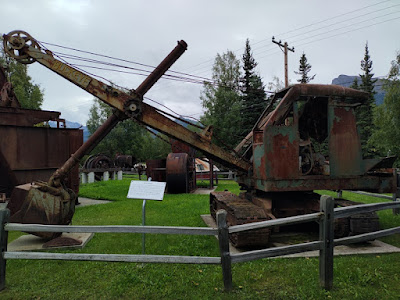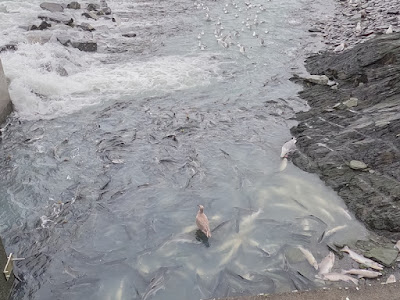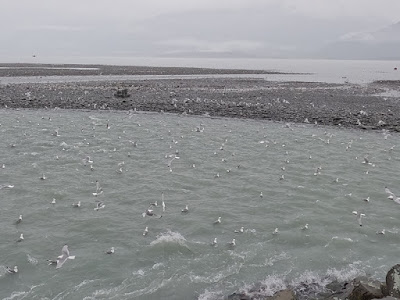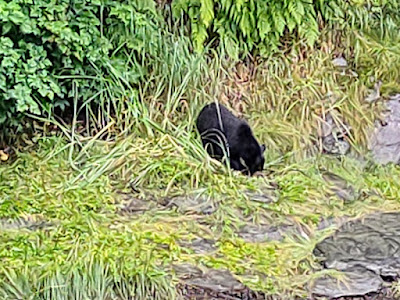We detoured along a dirt road to go to Hope, at the recommendation of a local. This Social Hall was built in 1902 and has been in continual use since then. The day we rolled in, they were holding a square dance in the hall.
Another building from the turn of the century in Hope.A log bench in Hope.
A dragonfly victim to van travel. This unfortunate one was stuck on our front bumper.
Jason on Main Street in Hope, Alaska on another rainy day.
One of the old buildings now turned into a restaurant in Hope.
An example of 'combat fishing' for salmon at the estuary in Hope. A good ol' boy from Arkansas told us he'd go back out after the crowd left and if we wanted to stick around he'd give us a fish if he caught some.
More combat salmon fisherpeople.
A bag of blueberries I picked along the road near Homer.
Art, a Native Alaskan, claimed he was the best catcher and cooker of salmon around. He grilled these 2 huge chunks of marinated silver salmon for us just so we could say we'd had some. He makes the skin crispy and declared it a delicacy, so I ate mine. It was pretty good!Art and Jason in Palmer.
We stopped at a Heritage Park near Chikaloon where old buildings from the mining era are preserved and on display. This was the old Post Office.
An old metal steam shovel in the heritage park.
A hide door at an old log lodge.
The lodge was used as a home during hunting season.
Karen with another bowl of raspberries I picked.
These golden hills aren't from gold or copper, but from an oxidized gypsum. Still very pretty.
We stopped here along the road for lunch--peanut butter and raspberry sandwiches.
The oxidized gypsum lines the stream that flows down the hillside.
A plant called strawberry blight. Natives use it for dye.
A wooden fish wheel on display at the visitor center for the Wrangell-Elias National Park. This park is the largest in the network of national parks and extends into Canada as well. It covers over 42 million acres of land.
The brand 'INDIAN' stamped into the metal on a piece of abandoned equipment out at an abandoned campground we stayed at.
Moose scrapings on a tree near our campsite.
Some puffball mushrooms I found and ate with dinner. Jason won't touch them, but all puffballs are good to eat as long as they are still all white inside.
A mix of crow berries/moss berries and low bush cranberries/lingonberries. The blue crow berries have little flavor but can mix with others as an extender.
Looking down a waterfall on a deep gorge to the silty grey water below.
Jason looking down at the river from a bridge on our way south.
Glaciers from the roadside view.
A river of water down a mountainside, aka a long waterfall.
Under all that black dirt is more blue ice of a glacier.
An unfinished railroad tunnel through the rock. A gunfight erupted between two parties during the build and it was abandoned.
A sign next to the road explains the tunnel.
Karen in front of the tunnel opening. It isn't a very big tunnel.
The unfinished tunnel next to the road nearing Valdez. I liked the orange lichens on the rock, too.
Bridal Veil Falls on the road to Valdez.Bridal Veil and Horsetail Falls. There seem to be several falls with these names here.
The drive down into Valdez is loaded with beautiful waterfalls along the way.
Jason in front of Horsetail Falls.
People hanging their salmon and other fish for photos in the Valdez harbor. There was a fishing derby going on.
Karen in full rain gear with the 2 slabs of silver salmon some guy gave me. He'd overheard me asking a guy if he had any extra and walked over and handed me these.
These 2 guys from Pierre, ND were the ones who gave us the salmon. They'd been fishing daily for the last couple of weeks and had a huge laundry tub of fish they'd caught and cleaned today. The fillets they gave looked like they were professionally cleaned. They were awesome. It was pouring rain so the photo was taken through a plastic zip-lock baggie.
This guy brought the cleaned fillets over to me. Nice guys.
The cleaning tables were getting a lot of use this day. Everyone is expected to clean their fish here before leaving the harbor.This guy was struggling with the filleting techniques. Made a real mess of the fish but he wanted to try to take them all home to eat.
The pros cleaning a catch from a tour boat.
It wasn't only salmon they caught. They called these fish lingcod. Their eyeballs bulge out because they are brought up from the deep so fast. The pressure changes happen too quickly for the eyes to adjust.
The garbage chute from the cleaning station back down to the water. People clean their fish at the tables and wash the guts and carcasses back down into the water.
Our gift of salmon. We had several delicious meals out of these fillets.This was one meal.
W stopped at the salmon hatchery outside of town. It stunk of dead salmon and it was raining, so I let Jason go on the self-guided tour alone.
Lots of salmon, they all don't make it to where they should.
The seagulls are all those white specks. Thousands of them.Fish heading into the hatchery pens where they are caught and the eggs are saved to raise and distribute elsewhere.
Workers inside the hatchery processing the salmon for roe.
This waterfall cascaded down across the street from the hatchery. So much water created a spray all along the waterfall.
Dead salmon, spawned out, line the shore here. The smell was awful.This weir (a good Scrabble word) prevents the salmon from going any farther up the stream, which doesn't lead to anywhere except the waterfall. The salmon are encouraged to head into the pens where they are caught and the eggs are gathered and fertilized and the fish are raised until they can be released. Some are sent to other places to they can be released and think the other locations are their home waters so they will return to spawn there.
This young black bear is taking advantage of the salmon buffet available.
He's chawing down on a salmon across the ditch from the road just down from the hatchery.
He finishes one fish.....
and simply walks back to the edge of the water and grabs another one to eat.
Makes himself comfy and resumes dining.
So much rain here that waterfalls are everywhere! The seagulls are here for the salmon, too.
The rain started to flood the area and we decided to get out of Valdez.
Jason at Bridal Veil Falls on the way back out of Valdez.
The water makes pretty designs as it falls and bounces off the rocks.
So much power in that water behind Jason. Gives you some scale as to the size of these falls.
The longest piece of straight road we've seen in a long while. You can see the ripply surface, often caused by frost heaves.
We detoured along the McCarthy Road. You can take this road out for miles into the Wrangell-Elias National Park, but it isn't paved beyond a few miles in. This cut in the rock is only wide enough for one vehicle at a time.
We drove through and turned around and drove back out.
Warning signs about the McCarthy Road beyond the rock cut.
The sign warns that it isn't a good drive for us. We had no intention of going any farther.
We stopped at Liberty Falls for lunch.
The green of this water is from the green rocks on the bottom of the riverbed. So many pretty green rocks here. Much is serpentine.A pretty roadside stop, these Liberty Falls.
Peanut butter and just-picked blueberry roll-ups for lunch. Awesome!
A large flat parking area near a failed permafrost vent project, we were surprised it didn't have any signs saying we couldn't park there overnight. The next morning, we found the signs laying in the tall grass behind the trash cans and outhouse. Jason posed them for this shot.













































































No comments:
Post a Comment